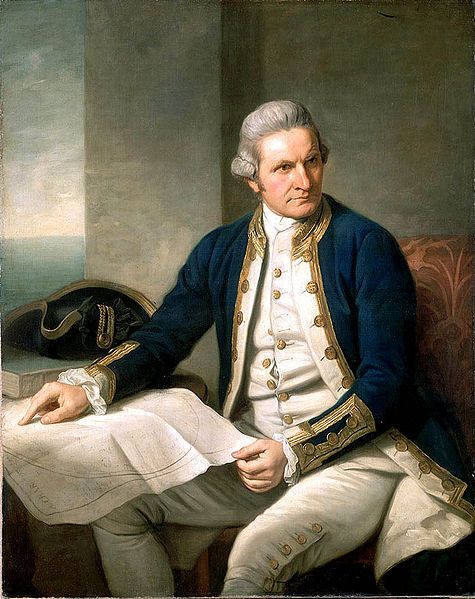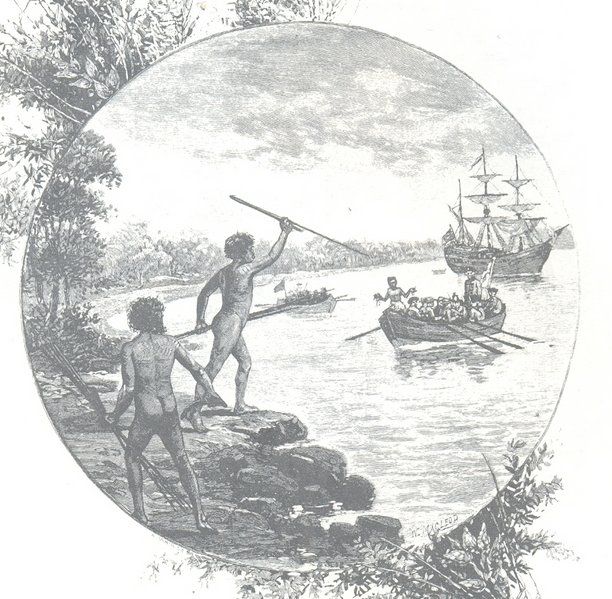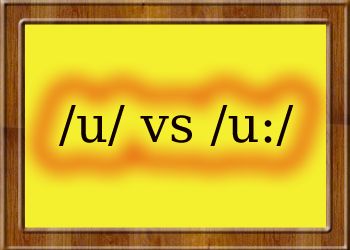5. Solved exercises
Captain Cook's early life1
After visiting the Opera House, Paco wanted to know more about when, why and who colonized Australia and turned it into a place to take all kinds of convicts from the British Isles. Thus, he visited the Australian National Maritime Museum at Sydney's Darling Harbour, where he could read and see documents about the well known British navigator and explorer, Captain Cook.
 |
| By Nathaniel Dance. Public domain |
Captain James Cook was born in the village of Marton in Yorkshire, which today is a suburb belonging to the town of Middlesbrough, in 1728. He was baptised in the local church of St. Cuthbert's where today his name can be seen in the church register. Cook was the second of eight children of James Cook, a Scottish farm labourer, and his locally born wife Grace Pace from Thornaby on Tees. In 1736, his family moved to Airey Holme farm at Great Ayton, where his father's employer, Thomas Skottowe paid for him to attend the local school, which is a museum nowadays. In 1741, after five years schooling, he began to work for his father, who had by now been promoted to farm manager. For leisure he would climb a nearby hill, Roseberry Topping, enjoying the opportunity for solitude. Cook's Cottage, his parents' last home, which he is likely to have visited, is now in Melbourne, having been moved from England and reassembled brick by brick in 1934.
In 1745, when he was 16, Cook moved 20 miles (32 km) to the fishing village of Staithes to be apprenticed as a shop boy to grocer and haberdasher William Sanderson. Historians have speculated that this is where Cook first felt the lure of the sea while gazing out of the shop window.
After 18 months, not proving suitable for shop work, Cook travelled to the nearby port town of Whitby to be introduced to friends of Sanderson's, John and Henry Walker who were prominent local ship-owners and Quakers, and were in the coal trade. Their house is now the Captain Cook Memorial Museum. Cook was taken on as a merchant navy apprentice in their small fleet of vessels plying coal along the English coast.
 |
| By Adam Carr (illustration from "Australia: the first hundred years", by Andrew Garran, 1886). Public domain |
As part of this apprenticeship, Cook applied himself to the study of algebra, geometry, trigonometry, navigation and astronomy, all skills he would need one day to command his own ship.
His three-year apprenticeship completed, Cook began working on trading ships in the Baltic Sea. He soon progressed through the merchant navy ranks, starting with his 1752 promotion to Mate (officer in charge of navigation) aboard the collier brig Friendship. In 1755, within a month of being offered command of this vessel, he volunteered for service in the Royal Navy, as Britain was re-arming for what was to become the Seven Years' War. Despite the need to start back at the bottom of the naval hierarchy, Cook realised his career would advance more quickly in military service and entered the Navy at Wapping on 7 June 1755.
He died on February 14, 1779.
1 Adapted from Wikipedia.org
Answer the following questions:
1. According to the text, why did Captain Cook have the chance to attend school at Great Ayton?
2. According to the text, what happened to Cook's Cottage?
3. Why did Captain Cook enter the Navy in 1755?
Let's have a look at some sentences from the passage above which contain a relative clause:
- Thus, he visited the Australian National Maritime Museum at Sydney's Darling Harbour, where he could read and see documents about the well known British navigator and explorer, Captain Cook.
- Captain James Cook was born in the village of Marton in Yorkshire, which today is a suburb belonging to the town of Middlesbrough, in 1728.
- Cook travelled to the nearby port town of Whitby to be introduced to friends of Sanderson's, John and Henry Walker who were prominent local ship-owners and Quakers.
Answer the following questions:
1. There are four relative clauses in the sentences, which ones?
2. Which are defining and which ones non-defining?
3. Can you recognize the relative pronouns in each of them?
4. And how about the antecedents of those pronouns?
Let's concentrate on defining relative clauses for a while. In order to do so, surf the web to find a good English definition for the following words from the passage:
| convict (n.) - navigator - suburb - farm |
Remember that one of the questions in PAU tests is related to a real situation.
Imagine a friend of yours wants to join the navy because he doesn't know what else he/she could do for a living. Tell him/her not to do so giving him/her a good reason.
 |
Write the following sentence in the forms and tenses asked in the chart: "For leisure he would climb a nearby hill, Roseberry Topping, enjoying the opportunity for solitude."
| Tense and form |
Answer |
| Future | |
| Present Perfect Continuous | |
| Interrogative of the Present Perfect | |
| Present Continuous | |
| Interrogative negative | |
| Interrogative of the Past Simple |
 |
Another question in the PAU is, as you may already know related to pronunciation. In it, remember that you are asked to find two words in the text which contain the same sound as a word which is provided. Normally, the sounds asked are long vowels, short vowels, diphthongs, and, very occasionally, triphthongs.
Find as many words as you can in the text containing vowels that are pronounced in the same way as
| o in moved |
... ... ... ... ... |
|
u in museum |
... ... ... ... ... |
(Underline the part of the word that contains the sound).